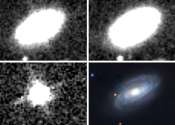Survey of star masses in early universe analog shows distribution is not radically different from present day clusters
Observations of a star forming region on the outskirts of the Milky Way galaxy, where conditions from the early universe are still preserved, found that the distribution of stellar masses is not radically different from what ...









